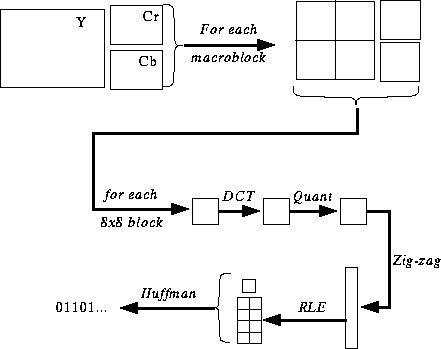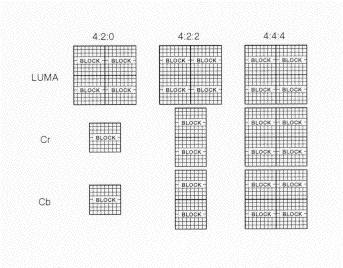
The term intra frame coding refers to the fact that the various lossless and lossy compression techniques are performed relative to information that is contained only within the current frame, and not relative to any other frame in the video sequence. In other words, no temporal processing is performed outside of the current picture or frame. This mode will be described first because it is simpler, and because non-intra coding techniques are extensions to these basics. Figure 1 shows a block diagram of a basic video encoder for intra frames only. It turns out that this block diagram is very similar to that of a JPEG still image video encoder, with only slight implementation detail differences.

This is a basic Intra Frame Coding Scheme is as follows:
A macroblock usually consists of 4 Y blocks, 1 Cr block, and 1 Cb block.
In the example HDTV data rate calculation shown previously, the pixels were represented as 8-bit values for each of the primary colors red, green, and blue. It turns out that while this may be good for high performance computer generated graphics, it is wasteful in most video compression applications. Research into the Human Visual System (HVS) has shown that the eye is most sensitive to changes in luminance, and less sensitive to variations in chrominance. Since absolute compression is the name of the game, it makes sense that MPEG should operate on a color space that can effectively take advantage of the eye¹s different sensitivity to luminance and chrominance information. As such, H/261 (and MPEG) uses the YCbCr color space to represent the data values instead of RGB, where Y is the luminance signal, Cb is the blue color difference signal, and Cr is the red color difference signal.
A macroblock can be represented in several different manners when referring to the YCbCr color space. Figure 7.13 below shows 3 formats known as 4:4:4, 4:2:2, and 4:2:0 video. 4:4:4 is full bandwidth YCbCr video, and each macroblock consists of 4 Y blocks, 4 Cb blocks, and 4 Cr blocks. Being full bandwidth, this format contains as much information as the data would if it were in the RGB color space. 4:2:2 contains half as much chrominance information as 4:4:4, and 4:2:0 contains one quarter of the chrominance information. Although MPEG-2 has provisions to handle the higher chrominance formats for professional applications, most consumer level products will use the normal 4:2:0 mode.

Macroblock Video Formats
The Macroblock is coded as follows:
